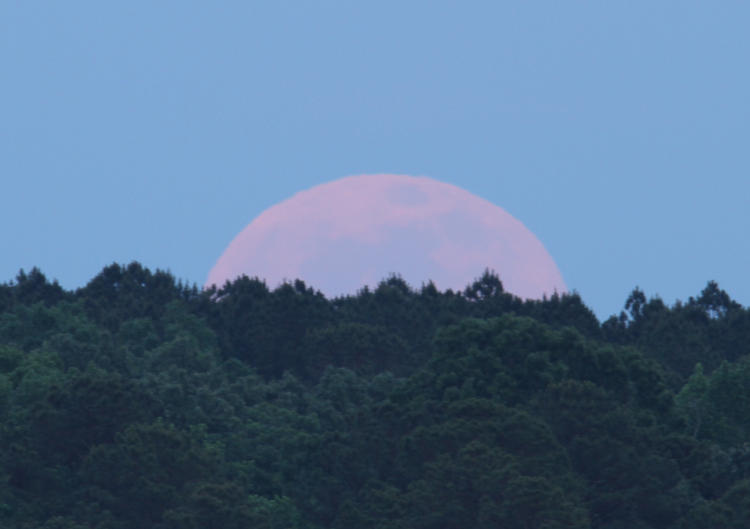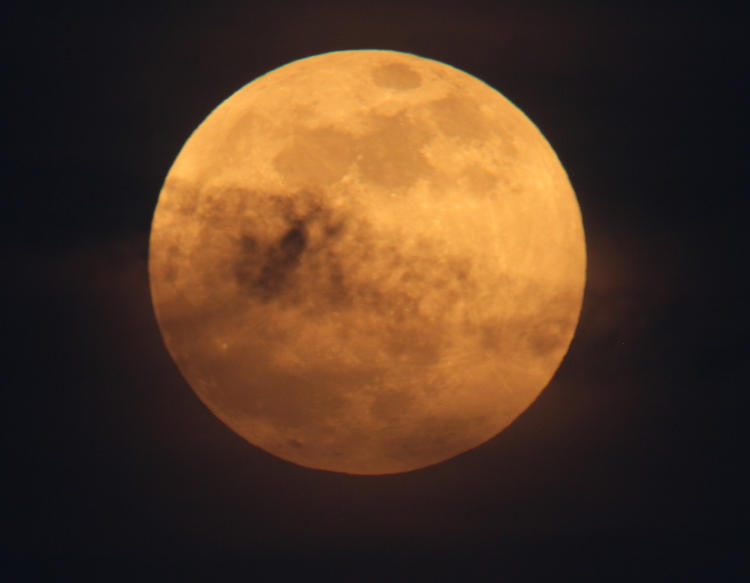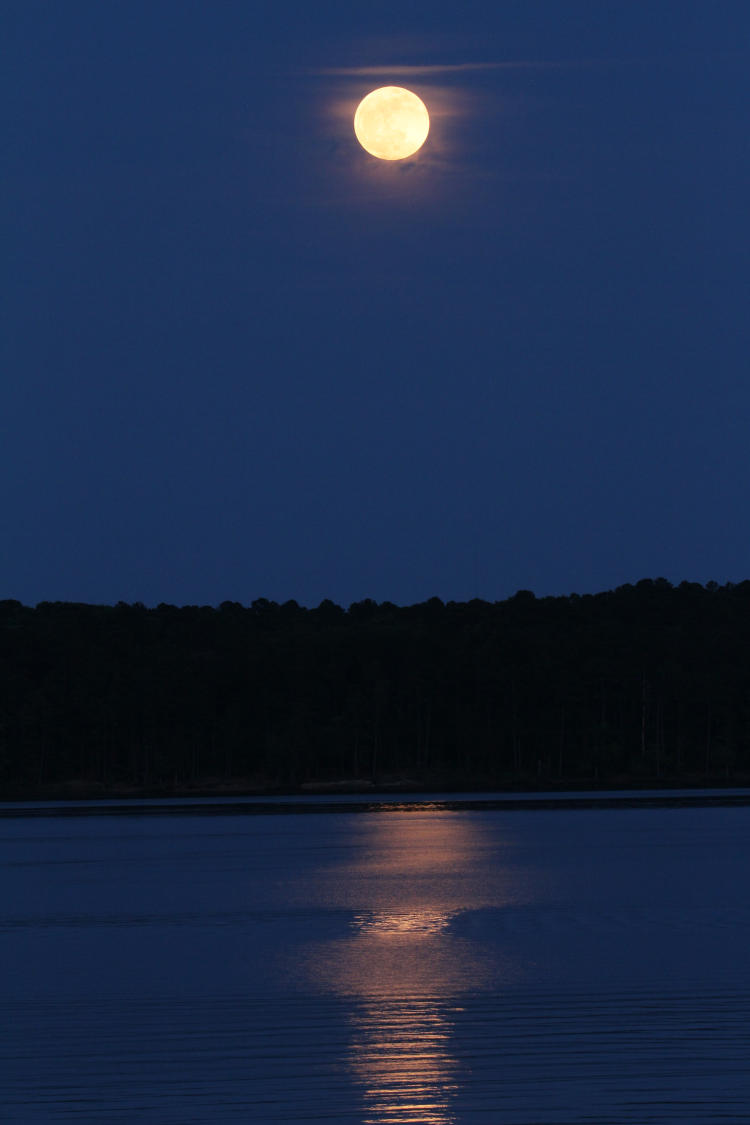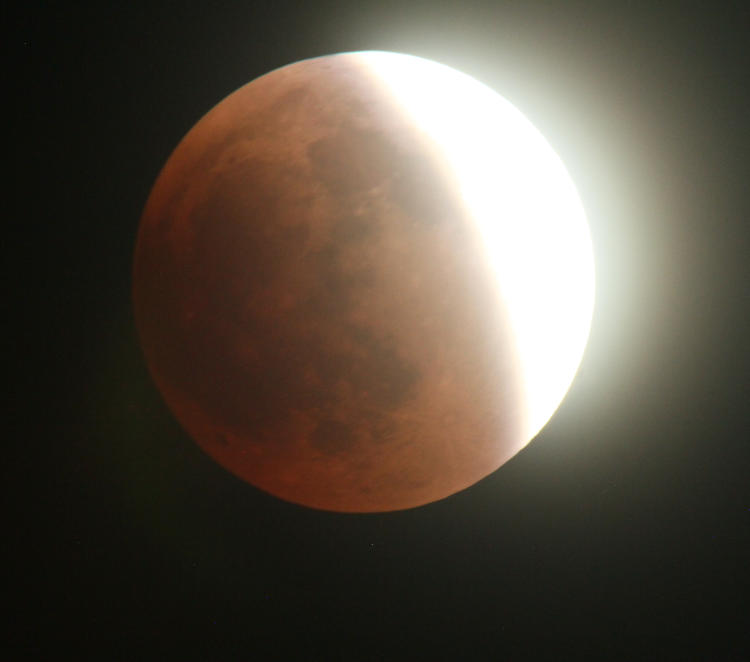You didn’t think I was just going to leave you with one eclipse pic, did you?
I’d been eyeing the weather reports all week, because we’ve been having spates of thunderstorms and sudden showers, and they called for partly cloudy conditions Sunday night when the eclipse was occurring, so I wasn’t getting my hopes too high. Nonetheless, when the day had remained mostly sunny, I went down to the lake near sunset to catch both the sunset and the moonrise, if possible. Sunset proved to be almost completely clouded out, and there were visible dark bands along the eastern horizon where the moon was to appear, so I was a bit surprised to see the pink head crowning from the trees.

Apparently, the dark band I was seeing was thinner humidity than it appeared, perhaps enhanced by the Belt of Venus, but hey, I was happy with it. As it rose, the moon passed in and out of several cloud bands, fully obscured for a minute or three, then revealed again. I managed a few pics.

If I’d been after lunar detail, I’d have been out of luck, but fartsiness? There was enough of that to work with.
The moon climbed out of its pink phase and into gold, still quite photogenic, and while I didn’t intend to do a whole gallery, in 22 minutes I snagged plenty of keepers while the clouds played supporting roles.

As the conditions darkened, I watched a bald eagle cruise over the foreground water and catch a fish, but the shutter speed would be too slow for any moving subject, and I waited in vain for the eagle to rise in front of the moon. Such opportunities are far fewer than you might suspect, given that the moon takes up a tiny fraction of the visible sky, even if you only count up to 25° from the horizon – I know, I’ve tried this for decades, with both sun and moon. But I went wider for a landscape shot, even if it was portrait orientation.

The moon wouldn’t enter the umbral phase of the eclipse for a few hours yet, and the penumbral is boring, so I went home and unloaded the initial images, making a quick post before returning for the real action – if you can count a shadow advancing far too slowly to discern as “action.” And there were still patches of thick clouds in the sky, here and there, as the time drew close, including a smallish bank doing a striptease with the moon as things should have been noticeable.

Large portions of the sky remained clear, however, so I figured, as slow as things went, I should still get enough photos to make it worthwhile. Soon afterward, the clouds dropped away, except for a pesky one in the lower corner which wasn’t actually a cloud.

This was the Tamron 150-600 with a 2x converter, using a remote release and mirror lock-up with about a five-second delay, and I did numerous frames during this period that I then zoomed way in on, using the LCD on the back of the camera, to examine for critical sharpness. Once I had it as sharp as I figured it was possible, I left the focus ring there (manual focus of course) and used that throughout. Well, not quite true, because from force of habit I reached up once to tweak the focus, forgetting that I’d already gotten it as sharp as possible, and then had to do it all over again. But this only happened once.
And I missed one particular opportunity.

I realized just a little too late that a distant plane, on approach to the nearby airport, would pass in front of the partially eclipsed moon – again, this is extremely rare. Because of mirror lock-up, I had to hit the shutter release twice with several seconds in between, and the delay wasn’t enough while also being too much: the rig was still vibrating from the mirror slap and I tripped the shutter just a fraction of a second too late, so you’re seeing the tail and wingtip of the plane at the top edge there. Dammitall.
Just so you know, four more planes all passed within a few widths of the moon that night, and I snagged a bare portion of one’s nav beacons at the edge of the frame, but nothing worthwhile.
When the eclipse was roughly 2/3 advanced towards totality, you could still see the shape of the moon from the shadowed portion, and I adjusted exposure to bring this up distinctly.

As a comparison, the clear partial eclipse image above (the one without the plane) was 1/160 second, f11, at ISO 800. This one is 1.6 seconds, f8, at ISO 1600. That’s a 10-stop difference, and since each stop doubles the amount of light coming in, that means the light in this image is 1,024 times the amount of light in that one above. Okay, that’s technically not true, because there was far less light coming from the moon itself, but that’s what the camera was allowing for, anyway. It’s an illustration of necessary exposures.
Eventually, we reached totality.

This is just over an hour from the image further up that’s partially obscured by clouds, which was about when the umbral phase should have started – the exposure is 0.8 seconds, f8, at ISO 3200. That means plenty of grain, but with the minimal detail that could be captured anyway, it wasn’t really harming things – I’d need a big-barrelled telescope to get enough light to allow a lower ISO without inducing motion blur just from the passage of the moon (or a tracking motor,) and even then the adapting to the camera probably wouldn’t allow this kind of magnification. It’s very fussy, but someday I may have a digital sensor set up for a proper tracking telescope and produce something better than this. It’s actually in motion, but slower than the eclipse…
Yes, those are two stars in the frame, and one of them is the one I told you about earlier.
As the eclipse was approaching totality, I was playing around a little with video, but the frame rate of video means much shorter exposure times, and even with expanded ISO, what I captured was a bare glimmer of grey from the uneclipsed portion, slowly disappearing – there was absolutely no sign of the shadowed portion of the moon, so I didn’t bother with one idea that I had, which we’ll come to in a moment.

While waiting for that aforementioned event, I played around with exposures to see how bright I could make the moon without stretching out the shutter speed so long that there was motion blur and I lost detail. This was at 1 second, f8, ISO 6400, and I might have pushed it a hair further, like about 2/3 stop or so, but not more than that. It works for me.
Without the video option, as the moon moved in to eclipse that lower star, I settled for sequential frames.

This is just as it was disappearing. Partially because of the shutter speed and the mirror lock-up delay, it was about nine seconds to the next frame, and the star had completely vanished by then. I misjudged how fast it would actually disappear behind the moon, but I’m still glad that I stuck around for this attempt at a double eclipse, about half an hour after totality was achieved.
I decided to pack it up after that, but fired off a couple of frames to try and mimic the brightness that the moon appeared to have by naked eye, and this comes closest I think:

A lot smaller in the sky of course, and that remaining star (HIP 76106) was about 5.5 magnitude, just visible to the naked eye in good, dark conditions. I feel comfortable with this exposure because, as I was leaving the lake, I glanced up the road to check for traffic and the moon caught my eye, even through the car window – a dim glow, not too distinct.
That was a pretty good photo session, all from significant luck, some decent equipment, and a bit of experience with previous eclipses – I’m not complaining in the slightest. Even about the plane…




















































